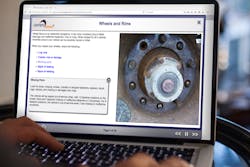Training, Safety And Maintenance
The pre-trip vehicle inspection. In the technology world, it’s called "doing QA” (quality assurance). QA is used to confirm a product is safe and ready to be used. But, sometimes things can go awry.
The pre-trip is our industry’s QA, and not doing it properly can be the root problem for a breakdown at the side of the road, or a failed roadside inspection. Both situations are a result of someone not paying attention to a vehicle defect, and/or not knowing how to do a proper inspection.
These incidents cost money, time and possibly some bad publicity if the breakdown causes a collision, fire or spill.
A good equipment inspection is going to mitigate the probability of these situations, but trying to get drivers to do a thorough inspection can be challenging for a number of reasons. In many cases, drivers aren't paid for the time they take on an inspection, and they want to get on the road faster where they will be paid for their time.
Maybe dispatch hasn't given them enough time to get to a customer and do the pre-trip inspection. Or perhaps, drivers don't even really know how to do a proper inspection.
What's important to realize is this is not solely a driver problem. Yes, the driver should be inspecting the vehicle, but that's not the whole story. To make sure vehicle inspections are done properly requires a combination of training, practice and feedback, along with the cooperation of drivers, maintenance and safety.
Why Training?
The purpose of training is to give drivers an understanding of why inspections are important, how to develop the habit and, most importantly, what to look for during the inspection. They need to be vested in the importance of doing the pre-trip, and not the ramifications – good and bad – for the company they drive for.
Drivers should be taught what defects look like at every point on the vehicle, along with best practices and tips for completing the job.
Like good QA, the most important part of an inspection is to follow a process that covers all possible points of failure and be able to repeat that process the same way every time. The safety department plays a major role in a driver's success by providing defined guidelines and standards to follow.
Why Practice?
Online training and defined guidelines are a great way to provide drivers with the knowledge they need to do a complete inspection, but it doesn't give them the hands-on practice necessary to master the task. Just watching a trainer do the inspection won't necessarily help that much, either.
Drivers need the opportunity to practice themselves. With practice, drivers can begin to conduct inspections faster and more accurately.
CarriersEdge (www.carriersedge.com), a provider of online safety and compliance training tool for the North American transportation industry, in partnership with the Truckload Carriers Association (www.truckload.org) conducts the annual Best Fleets to Drive For program. In this program, CarriersEdge officials hear about innovative programs that the top 20 carriers in the Best Fleets are using to reinforce good inspection practices.
Nussbaum Transportation (www.nussbaum.com) uses a driver-coach to provide hands-on training to drivers who need assistance. Transpro Freight Systems (www.transprofreight.com) stages "inspection challenges" for contractors during safety meetings where drivers compete to find the most defects on a trailer in 5 minutes.
Why Feedback?
Not only do drivers need the opportunity to practice inspections, they also need constructive feedback on their performance. This is where the safety and maintenance departments have important roles to play.
Motor Carrier Service (www.mcstrucks.com) conducts hands-on practice during safety meeting rodeos. In addition, new drivers spend half a day in the shop during their orientation at which time maintenance personnel provides training on basic repairs and sets expectations about completing pre-trips and reporting defects. By doing this, the company provides a solid foundation for ongoing communication.
For the last few years, we've also seen more fleets giving drivers a bonus for a clean Commercial Vehicle Safety Alliance (CVSA) Level 1 inspection. Rewards are a great form of positive feedback for drivers, but Motor Carrier Service goes a step further. Not only is there a bonus for the driver, but the shop employee working with that vehicle also gets one, encouraging both drivers and maintenance to work together.
Teamwork pays, literally and figuratively.
QA Failure
Every time you see a recall on the news because a product malfunctioned or a software bug allowed hackers to steal information, it's a failure of QA. In the trucking world, to avoid a failure during an equipment inspection, there must be a company effort with cooperation between the drivers, safety and maintenance departments.
The more a company puts toward continuous learning, feedback and rewards, the better the outcome.
Ongoing communication will help ensure good inspection practices and that means you can relax during the next roadside vehicle inspection blitz because it your trucks won’t be sidelined, sitting on the side of the road for failing the inspection.
Jane Jazrawy is the CEO of CarriersEdge (www.carriersedge.com), providers of online safety and compliance training tools for the North American transportation industry, and co-creator of the Best Fleets to Drive For program. She has been a leader in education and performance improvement for more than 25 years, and through Best Fleets, works to promote positive and diverse workplaces in the trucking industry.
